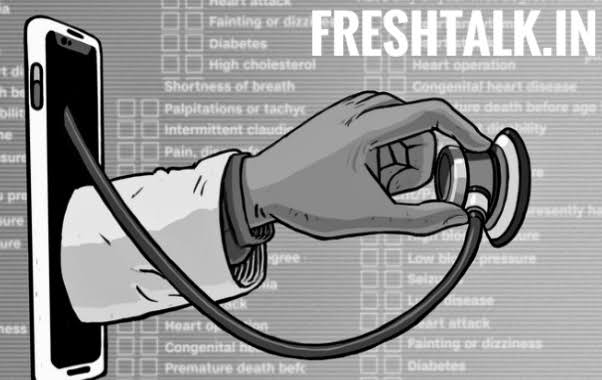Telemedicine is the circulation of health-related services and data by means of electronic data and telecommunication technologies. It permits significant distance patient and clinician contact, care, guidance, updates, instruction, intercession, observing, and remote admissions. Telemedicine is once in a while utilized as an equivalent word or is utilized in an increasingly constrained sense to depict remote clinical administrations, for example, analysis and checking. At the point when country settings, absence of transport, an absence of portability, diminished financing, or an absence of staff limit access to the mind, telehealth may overcome any barrier.
Just as supplier separation learning; gatherings, management, and introductions between experts; online data and health data management and human services framework integration. Telehealth could incorporate two clinicians discussing a case over video meeting; an automated medical procedure happening through remote access; active recuperation done by means of advanced observing instruments, live feed and application mixes; tests being sent between offices for translation by a higher authority; home checking through consistent sending of patient health information; customer to the professional online meeting; or even videophone understanding during a counsel.
Telemedicine includes the utilization of media communications and virtual innovation to convey social insurance outside of conventional human services offices. Telehealth, which requires getting to just to broadcast communications, is the most fundamental component of “eHealth,” which utilizes a more extensive scope of data and correspondence advancements (ICTs).
Telemedicine models incorporate virtual home human services, where patients, for example, the constantly sick or the older may get direction in specific strategies while staying at home. Telehealth has likewise made it simpler for human services laborers in remote field settings to get direction from experts somewhere else in finding, care and referral of patients. Preparing can here and there likewise be conveyed by means of telehealth plans or with related advances, for example, eHealth, which utilize little PCs and web.
All around planned telehealth plans can improve social insurance access and results, especially for incessant ailment treatment and for helpless gatherings. In addition to the fact that they reduce requests on packed offices, however, they additionally make cost reserve funds and make the wellbeing division stronger.
Since remote correspondence and treatment of patients diminishes the quantity of visits for wellbeing administrations, both vehicle related outflows and discharges identified with operational necessities are decreased. Also, less space requests can conceivably bring about littler wellbeing offices, with simultaneous decreases in development materials, vitality and water utilization, waste, and by and large ecological effect.
Telehealth has been appeared to overcome barriers to wellbeing administrations brought about by separation among patient and supplier, access to dependable transportation, fracture of care because of holes in time among arrangements, and absence of accessible suppliers.
Telemedicine builds access to mind.
Separation and travel time among patients and care suppliers can restrain access to the mind. Luckily, telemedicine can conquer geographic boundaries to human services, particularly for specific suppliers. Telemedicine can be especially valuable for patients in medicinally underserved networks and those in provincial geological areas where clinician deficiencies exist.
Telemedicine improves nature of care conveyance
Telemedicine can improve the nature of care for patients with both clinical and psychological well-being conditions. A recent study showed that with telemedicine, patients had:
38% less emergency clinic affirmations
31% less emergency clinic re-affirmations
63% bound to spend fewer days in the emergency clinic
Were increasingly occupied with their medicinal services
Telemedicine lessens medicinal services costs
Telemedicine can build the proficiency of care conveyance, lessen costs of thinking about patients or shipping to another area, and can even keep patients out of the emergency clinic. Truth be told, one investigation indicated that telemedicine care had 19 per cent savings over inpatient care cost.
Telemedicine upgrades conventional vis-à-vis medication
A solid specialist tolerant relationship is the establishment for top-notch understanding consideration and lessening human services costs. Telemedicine should bolster, not supplant, customary consideration conveyance. With telemedicine care suppliers can keep on thinking about patients in-person care while as yet giving the adaptability and accommodation of seeing patients remotely for follow up visits, registration, and instruction when proper or vital.

Telemedicine improves quiet commitment and fulfilment
Telemedicine makes it simpler and increasingly advantageous for patients to remain solid and occupied with their medicinal services. Patients love the comfort, adaptability and ongoing consideration with their suppliers.
Telemedicine improves supplier fulfilment
Being a medicinal services supplier today can be testing and distressing now and again. Telemedicine can improve work fulfilment by making it simpler to meet with patients. Suppliers can utilize telemedicine to make it simpler to adjust their work and family life. Read Dr Shaya’s blog post about expanding her activity fulfilment with telemedicine.
Telemedicine as the ‘utilization of media transmission procedures to give telemedicine, clinical training, and wellbeing instruction over a separation’, while drawing a qualification among this and telemedicine, which is characterized as the ‘utilization of cutting edge telecom innovations to trade wellbeing data and give human services benefits across geographic, time, social and social obstructions’.
Telemedicine administrations use data and correspondences innovations (ICTs) to convey wellbeing administrations and transmit wellbeing data over both long and short separations. It is tied in with transmitting voice, information, pictures and data instead of moving consideration beneficiaries, wellbeing experts or teachers. It includes analysis, treatment, preventive (instructive) and remedial parts of social insurance administrations and normally includes care recipient(s), care suppliers or teachers in the arrangement of these administrations coordinated to the consideration beneficiary.
Video-conferencing is one of the primary manners by which telehealth is improving access to human services administrations for patients who live in territorial, country and remote zones.
Rather than making a trip to the closest significant city to see a pro, an expanding number of patients are utilizing video-conferencing. This office may be offered by their nearby GP or another neighbourhood medicinal services setting.
An apparatus that makes medicinal services increasingly open, financially savvy, and that builds tolerant commitment – is telemedicine. Since making its introduction in the late 1950s, progresses in telemedicine has added to seniors having the decision to age set up. What’s more, the patients that live in provincial territories that recently experienced issues getting to a doctor would now be able to contact them for all intents and purposes.
Doctors and patients can share data progressively starting with one PC screen then onto the next. What’s more, they can even observe and catch readings from clinical gadgets in a faraway area. Utilizing telemedicine programming, patients can see a specialist for determination and treatment without hanging tight for an arrangement. Patients can counsel a doctor at the solace of their home.

